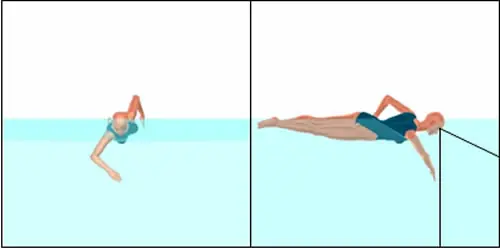Very often, the reason beginning swimmers struggle in the water is due to an ineffective breathing motion.
Excess head motion distorts the body position, increases resistance, and slows swimming speed. Mastery of breathing can make a huge difference in performance. Improving the breathing motion requires first optimizing the non-breathing head position.
Non-Breathing Head Position
While recommendations for the non-breathing head position have varied dramatically over the last century, the position that minimizes resistance has not. There is one head position that makes it possible to optimally orient the body when not breathing, and breathe without distorting the torso and legs. Cues (specific information about what to see or feel to orient the body parts) are a precise way to position the head and keep it stationary.
Feeling the water level just above the hairline is a kinesthetic cue that helps to effectively position the head (Figure 1). However, humans are better at processing visual information. Seeing both the pool wall and bottom within the field of view are visual cues that ensure an optimal head position.

Figure 1. The non-breathing head position from the front and side views. The side view shows that the
swimmer's field of view includes the pool wall and bottom.
Once the head is in an optimal position, it is much easier to orient the rest of the body. Arching the lower back lifts the legs to bring the heels to the surface. If the legs stay behind the torso (as in the front view of Figure 1), resistance is minimal. The smaller the area of the body perpendicular to the direction of motion (the body cross-section), the lower the resistance (Havriluk, 2005).
One of the many misconceptions about swimming technique is that the head must be submerged for the legs to stay behind the shoulders. Although lowering the head may help to raise the legs, breathing then requires excessive head motion that distorts the body and increases the cross-section.


